When talk first started among the Xokleng people about the historic cut-off point, locally known as the marco temporal, many of them, especially the elders, did not understand what it meant. “Who’s this Marco you all keep talking about?” Josefina Telé da Silva, 87, nervously asked one of her daughters. Many conversations were needed to make the meaning of these words clear. One way of explaining it was by talking about how things used to be: a child was born, learned to walk, to eat, to speak, to hunt, and to fish from the older members of the community, but it was only much later that they were registered as citizens in the city with the notary public. All of these experiences that came before and the lessons learned cannot be ignored, imagining that a life only starts once it has a birth certificate.
This didactic example helped the residents, especially the elders, of the Ibirama-Laklãnõ Indigenous Territory, in José Boiteux, in the Upper Itajaí Valley of Santa Catarina to understand the preposterous contents of the legal thesis behind the historic cut-off point, which set the date to be considered in court rulings on demarcation of Indigenous territories as October 5, 1988, the date of the Federal Constitution’s enactment. Based on this understanding, only Indigenous people already occupying their lands on this date would be entitled to them. The historic cut-off point fails to consider that many Indigenous people were removed, exterminated, or fled their territories in the years leading up to Brazil’s re-democratization. The Federal Supreme Court ruled the historical cut-off point unconstitutional – in other words, it violates Brazil’s Constitution.
Elders living in the Ibirama-Laklãnõ Indigenous Territory, like Josefina, joined teachers and students at Laklãnõ Elementary and Middle School to watch the hearings on the case. On September 20 and 21, in the village of Bugio, forty kilometers from downtown José Boiteux, another Indigenous group was keeping tabs on how each Supreme Court justice ruled from the yard of the Vanhecú Patté state school. A projector screen was set up in the village for the many residents who have no television at home to watch the proceedings. SUMAÚMA’s reporters saw how thrilled the Indigenous people were when the Court’s final vote was announced – 9 to 2 against the historic cut-off point. With the outcome of the long-awaited ruling announced, Josefina picked up her mandó (a cane made from the wood of a peroba tree by her house) and went to enjoy a cook-out being held by a group of parents. It was also a day of celebration for the Indigenous movement in Brasília.
Translating the Supreme Court’s ruling
Around 1,500 kilometers separate the school hall in the village of Bugio from the halls of the Supreme Court, located in Brasília’s Praça dos Três Poderes. Because this is a case with general repercussions, the justices met six days after the ruling to establish a final interpretation of their decisions. This means that the Court’s decision will apply to all future rulings in the country. “It’s a victory for the Indigenous movement,” sums up Deborah Duprat, a former federal deputy attorney general who represented Indigenous peoples on this case. Nevertheless, the Court’s ruling has also raised plenty of questions and concerns about the future of demarcations.
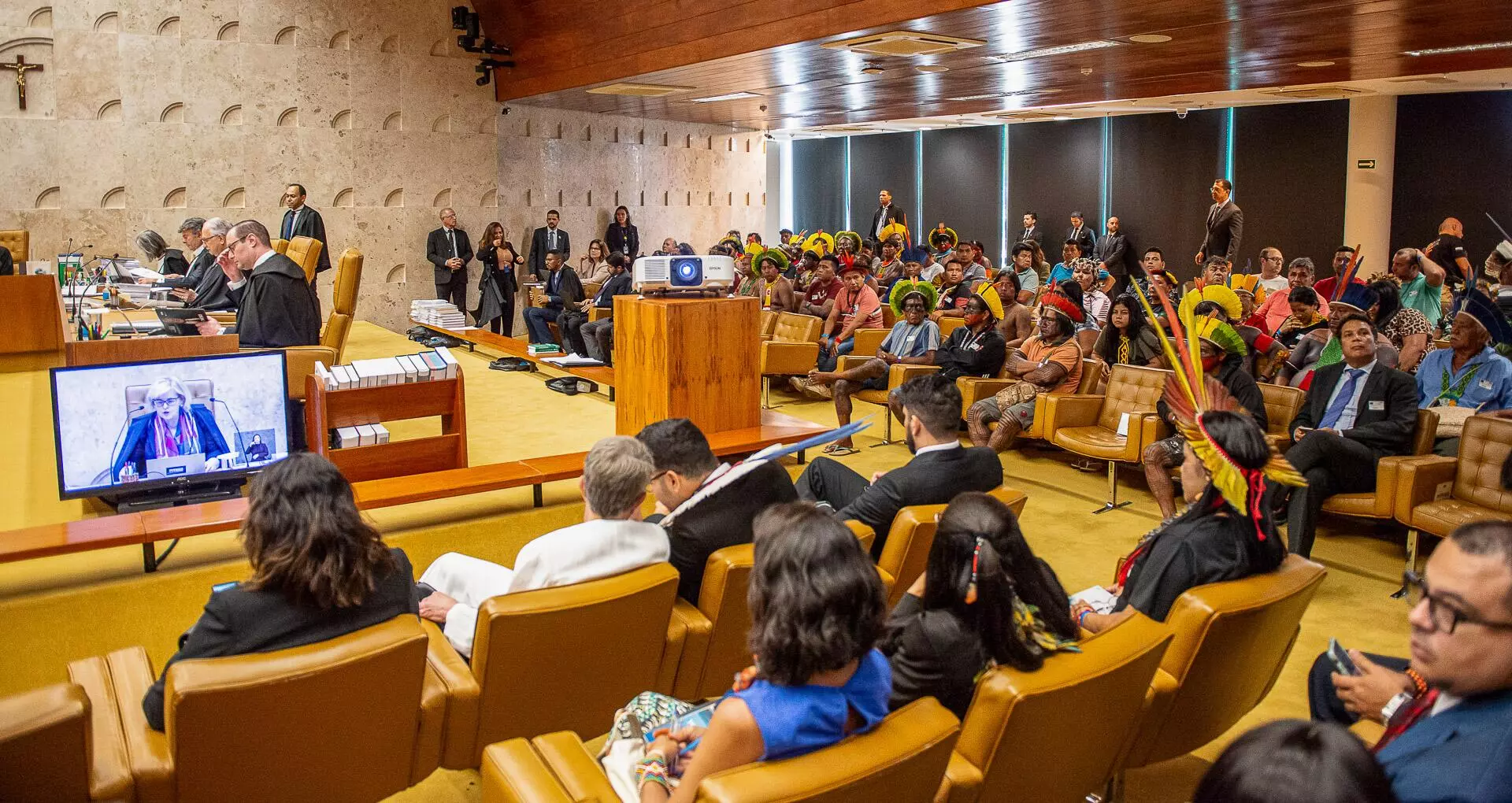
Indigenous peoples attend the last session of Federal Supreme Court hearings: in September, the historic cut-off point thesis was rejected in a 9 to 2 vote. Photo: Matheus Alves/SUMAÚMA
The historic cut-off point was defeated, but in practice the Supreme Court justices’ ultimate interpretation ended up introducing different rules for demarcations moving forward when it comes to indemnifications that are supposed to be paid to people occupying territories recognized as Indigenous. Article 231 of the Brazilian Constitution states that territories demarcated as Indigenous are not entitled to indemnification, “except, pursuant to law, in relation to improvements resulting from good-faith occupation.” Put another way: if an illegal landholder occupied a territory that was later demarcated as Indigenous and the illegal landholder had a house there, indemnification would be paid for the house, but not for the land.
Nonetheless, the justices have now decided that prior indemnification would also be owed to non-Indigenous occupants for these territories in cases where native peoples were not in possession of them or if they were being disputed by native peoples on October 5, 1988. Such a complex decision will be even harder for Josefina to understand. Put another way, the Supreme Court recognized that the Constitution guarantees Indigenous people the right to the territories from which they were expelled prior to 1988, while also determining that non-Indigenous occupants of these territories must be indemnified for the land and everything they built there, if they had entered the area before it was disputed by Indigenous peoples.
Indemnification for open land: the focus of future conflicts
Nothing will change in contested territories or in those undergoing the demarcation process and that have already been demarcated provided that Indigenous peoples were in these locations or were disputing them in October of 1988. The problem is that there are dozens of areas where native peoples were expelled long before this date. Based on numbers from Indigenous movement organizations, such as the Alliance of Indigenous Peoples of Brazil (APIB), at least 100 territories are in this situation. It is for these around 100 territories that the so-called prior indemnification for open land now exists.
The high court determined that the “undisputed part” of the indemnification – the fair-value amount decided by the federal government for the area – needs to be paid before the non-Indigenous illegal landholder vacates the area. Until this payment is received, the illegal landholder is entitled to remain in the area. The measure could not only benefit those who purchased from the government itself land that was later disputed by Indigenous people, it could also benefit landgrabbers who have misappropriated public property and whose occupations were at some point legalized by the very same government or by state congresses run by ruralist blocs.
“Without fail, a valid title deed must be shown, one that was legally obtained [to be entitled to indemnification],” explains Deborah Duprat. However, she notes that “legalization of misappropriated public lands [in Brazil] happens much more as the result of laws that have been extending the validity of title deeds, even when they do not meet the requirements in place for this concession,” although there is obviously no room in the Supreme Court’s ruling for indemnification of these misappropriators.
The current situation has without question improved compared to before the case was heard, explains Daniel Sarmento, a constitutional lawyer and associate professor at Rio de Janeiro State University . “The idea that there is a historical cut-off point was rejected. But the introduction of prior indemnification is bad,” he says. “The Supreme Court has not made it harder to demarcate territories where Indigenous people were already present or disputing [territories] in 1988. In the rest [of the cases], however, managing to demarcate will be rather difficult because of the cost. To do the demarcation the government will have to spend a hefty amount,” explains the constitutional lawyer.
“The Supreme Court held out one helping hand, but created a serious obstacle with the other. If there is no money, no budget for this, there is no demarcation of these areas,” says attorney Rafael Modesto, who works for the Indigenist Missionary Council (CIMI) and who was also involved in the hearings on the historical cut-off point.
Former deputy attorney general Deborah Duprat also sees the high court’s decision as “an undeniable win.” “By rejecting the historical cut-off point, the National Foundation of Indigenous Peoples, the Ministry of Indigenous Peoples, and the Ministry of Justice were freed up to resume all of the demarcation processes that had been halted when the historic cut-off point was defined,” says Duprat. Likewise, court proceedings where the historical cut-off point was used in arguments to stop demarcations will have to comply with the Supreme Court’s decision.
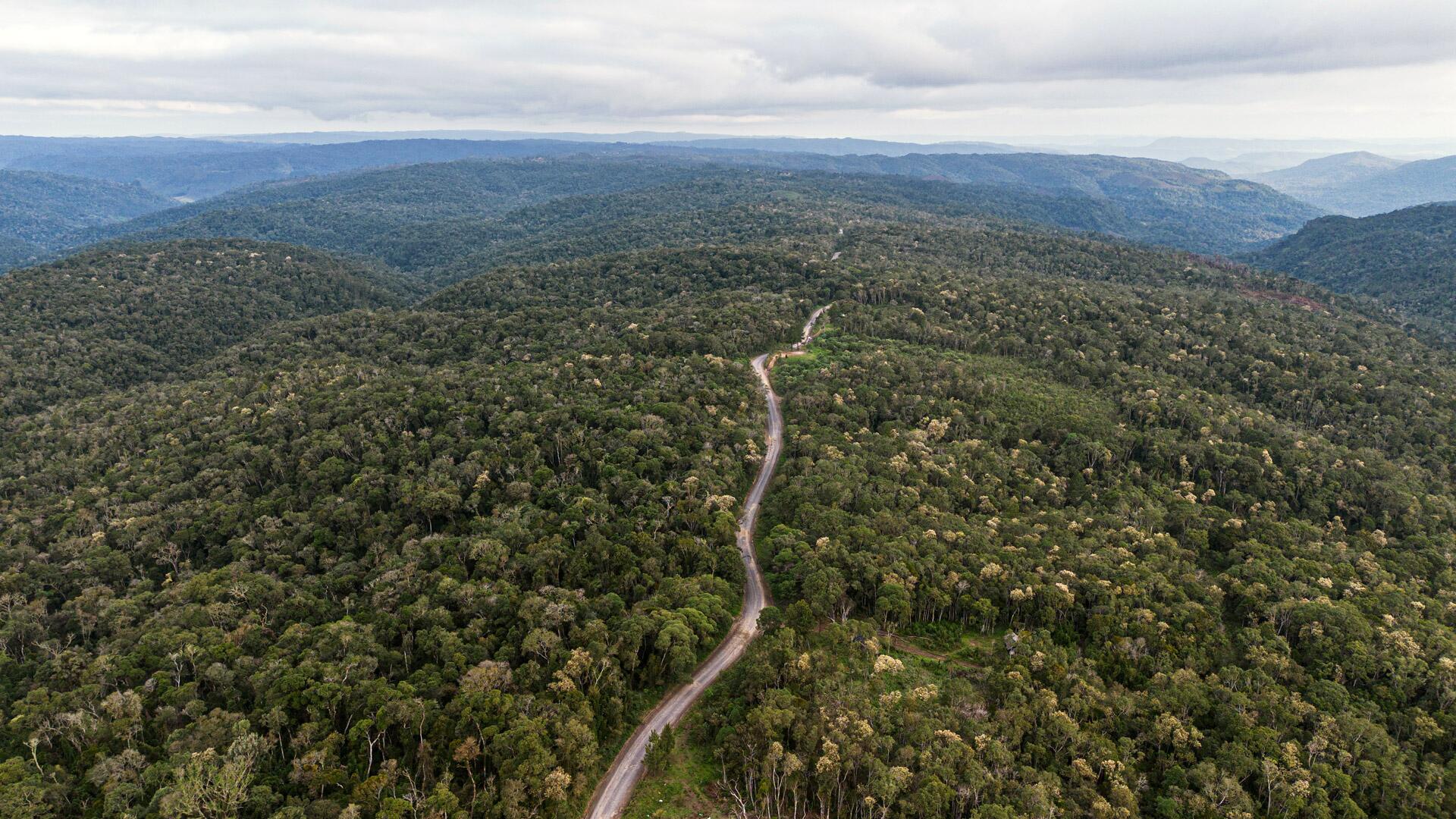
Ibirama-Laklãnõ Indigenous Territory: despite the Supreme Court’s rejection of the historic cut-off point, the demarcation process is likely to be affected. Photo: Anderson Coelho / SUMAÚMA
Indeed, the problem is the controversy around indemnification. “Because by deciding on the right to indemnification for open land in certain situations, the Supreme Court is creating some ambiguities. This needs to be better understood,” in the legal expert’s assessment. To do this, attorneys working on behalf of the Indigenous movement will file a final appeal known as a motion for clarification, asking the Supreme Court justices to elucidate points in their ruling.
The outlook is not good among those most familiar with the Indigenous movement’s legal struggle. “There is a tendency toward more conflicts, battery even, but also toward legal ownership of the land, with legal actions brought by landholders against the Indigenous people,” says CIMI’s Rafael Modesto.
Another problem with the court’s decision, according to attorneys representing the Indigenous people, is that it sets a five-year time period for native peoples to request expansion of their areas, a period that starts once these areas are officially demarcated — in the case of territories that are currently already demarcated, the clock is already ticking. “The Constitution guarantees Indigenous peoples the lands necessary for their physical and cultural reproduction, according to their uses, customs, and traditions. Yet we have the case of a group, in Minas Gerais, that had 3,000 individuals when their lands were demarcated, over five years ago. They now number 12,000 people. The land is no longer sufficient, but the deadline has passed. And now?” asks Deborah Duprat.
“The Federal Constitution states that the Indigenous people’s material and constitutional rights are not subject to the statute of limitations. Granting peremptory relief after five years on an Indigenous right that is not subject to the statute of limitations is terrible,” says Modesto.
Genocides continue to be perpetrated
Despite celebrating the win at the Supreme Court, attorney Roberto Liebgott, with the South region offices of the Indigenist Missionary Council (CIMI), notes that the dispute and the attacks will continue: “The ruling broke with this genocidal theory, but it didn’t get rid of those perpetrating genocides.” The political and economic pressure coming from those looting Indigenous territories, like landgrabbers, illegal mining operations and farmers, is still powerful, he notes. This was evidenced by a lightning-fast vote, held during the Federal Senate’s plenary hearing on the night of September 27, in support of the historic cut-off point, just six days after the Supreme Court’s ruling and on the same day the justices set rules for applying the court’s understanding throughout the judiciary.
According to attorney Roberto Liebgott, there has never been “such an articulated convergence of Indigenous peoples, from the country’s south to the north.” “Discussion of native rights brought them together in a single perspective, the guarantee of fundamental rights, to life and land,” he notes. However, Beto from CIMI, as Liebgott is popularly known, warns that this mobilization must continue. The fight endures and demands significant Indigenous mobilization in the three branches of federal government to block laws or constitutional amendments that attack native peoples’ rights.
Ivo Macuxi, a legal adviser with the Indigenous Council of Roraima who is involved in legal actions against the historic cut-off point, feels that there is a clear effect of discontent in the National Congress due to the Supreme Court’s dismissal of the historic cut-off point. “The people who don’t agree with the decision and want to revisit the issue of demarcation and exploit Indigenous lands are the same people attacking democracy, [attacking] a democratic State governed by the rule of law, who incite hatred and practice racism against Indigenous people in these same institutions. We need to move forward, create government policies of protection, and take care with what lies ahead,” warns Macuxi.
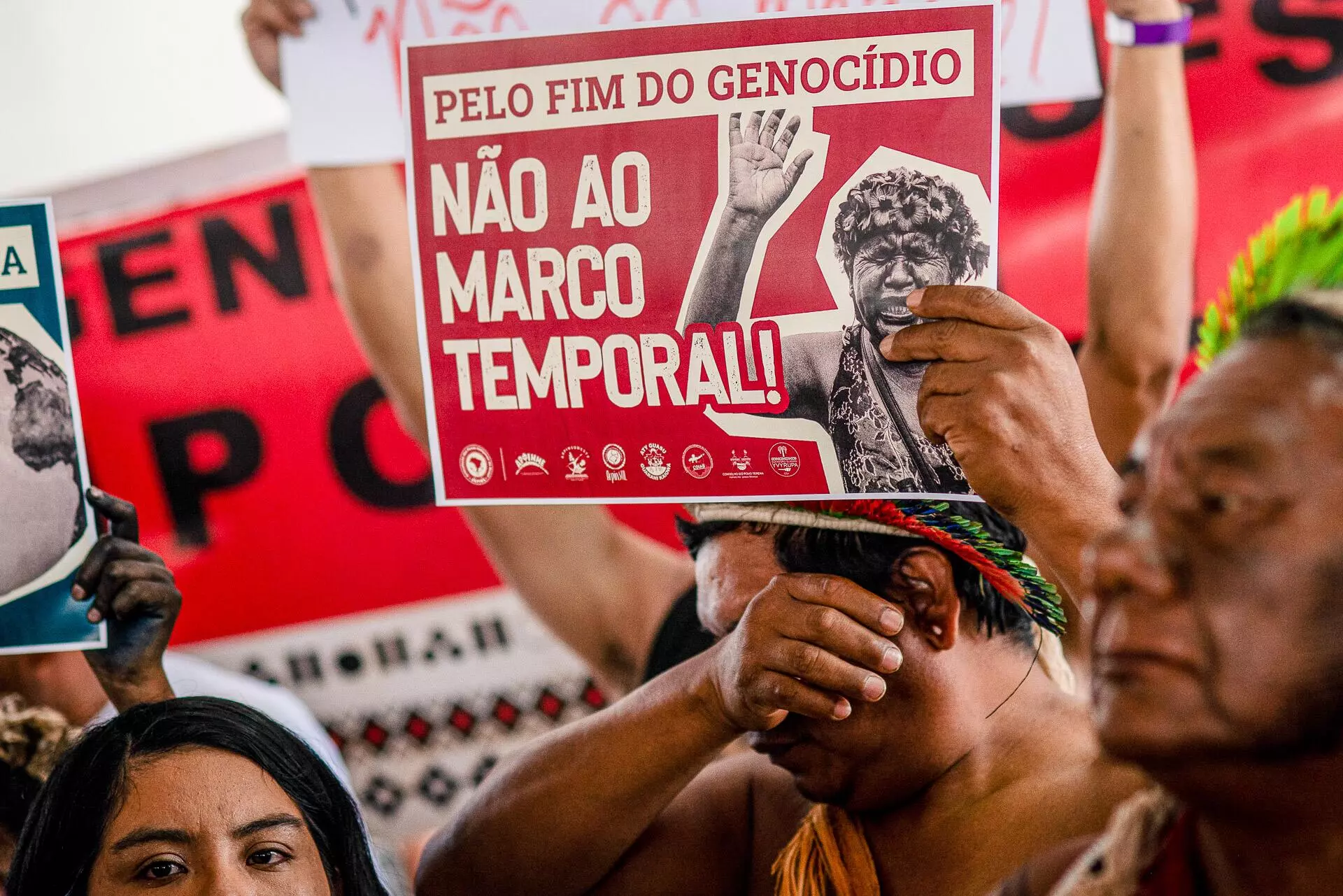
Indigenous peoples are overcome with emotion prior to the start of Supreme Court hearings on the historical cut-off point. Photo: Matheus Alves/SUMAÚMA
Even if in the end the Supreme Court case upheld Article 231 of the Federal Constitution regarding Indigenous rights to the territories they have traditionally occupied, the future remains uncertain for Indigenous people in Brazil. The bill the Senate passed to reintroduce the historic cut-off point and ignore the high court’s decision is now on President Luiz Inácio Lula da Silva’s desk. It will be up to Lula to sign or veto the bill, which Congress has named the Apocalypse Bill. Nevertheless, even a veto could be overturned by an absolute majority of 257 votes in the Chamber of Deputies and 41 votes in the Senate. This would inevitably send the proposed law back to the Supreme Court for consideration of its constitutionality.
The people of the sun who interweave past and future
The Xokleng, whose name for themselves is the Laklãnõ, are known as the ‘People of the Sun.’ It was under the sun’s light they ran to celebrate the defeat of the historic cut-off point.
In the yard of the Laklãnõ School, 74-year-old Patté Uvanhecu Filho danced with a bag full of papers slung across her chest. “I wept when the justices ruled in our favor, because I know about the Xokleng people’s suffering. Today we celebrate, but there was a lot of disagreement, a lot of separation. My companions have left [died], but God gave me the glory to live this day,” she says.
Listening to the elders means more than traveling the dusty roads of the villages and crossing wooden bridges. It requires stepping on the milestones of a history marked by extreme violence ever since whites began to occupy their territories, on highland slopes and in seaside valleys. It revives memories that are interwoven with the present. It means listening to life’s ups and downs, like those experienced by 75-year-old recent widower Ivo Clendo: “I believe that truth always wins and that what is in the law [the Federal Constitution] will help us,” Clendo predicts.
Wearing a beret and rubber boots, Clendo sits right next to the big screen to watch the hearing. His red jacket is a contrast to the justices’ dark robes, a ceremonial part of the Judiciary that extends down to their heels, a symbol of power. It was the first time that Clendo had left his home since his wife’s passing one week earlier. The old man is an example of the different types of violence brought upon the Xokleng people. Forty-five years ago, his family was forced to leave the fertile lowlands for a place where the soil was too acidic for crops, at 960 meters above sea level. “We fled the flooding, the snakes, the illnesses that the flooding brought.”
Named for a type of monkey formerly prized by Indigenous hunters, the village of Bugio was created to house those exiled by the fierce flooding of 1979, provoked by construction of the Norte Dam, a project begun under the military regime at the confluence of the Dollmann and Itajaí Norte rivers to prevent flooding in major cities in the Itajaí Valley, such as Blumenau and Ibirama.
At the time, the claim was made that if the dam were not built the people in the cities would be subject to flooding on the river. Local society was convinced by this narrative. The problem is that the Xokleng, who lost homes and farms, were never consulted. To this day, not one study has been done to assess the environmental, socio-cultural, and psychological impacts on the Indigenous population from the dam’s construction. “That seemed like a deluge. We grabbed what was left and started going up, up. I could live 500 years, but I’ll never forget what happened from the dam,” recalls Clendo.

Xokleng children (at left) watch the Supreme Court hearings from the village of Bugio. Ivo Clendo (at right) recalls the time, 45 years ago, when his family was forced to leave their territory. Photos: Anderson Coelho/SUMAÚMA
And the pains of the past always return to haunt them. On Saturday, October 7, the government of the state of Santa Catarina decided to close two of the dam’s floodgates. Done without the backing of a technical report and just days after the state’s own government had ruled against the closure based on a “lack of safety,” it was aimed at containing flooding on the Itajaí Açu River in cities along the Itajaí Valley, due to the heavy rains devastating the region. At one point an agreement on an operation to close the gates was reached between Indigenous leaders, the government, and the municipal government of José Boiteux, with oversight from the Federal Public Prosecutor’s Office and Funai, Brazil’s Indigenous affairs agency. Yet there would need to be a trade-off: Governor Jorginho Mello (Liberal Party) would need to urgently provide a bus, three boats, drinking water, basic food staples, and four healthcare posts for the Indigenous people. These demands considered the risk of flooding in the villages in the event the dam would not support the volume and force of the water. On Sunday morning, a group of around thirty Xokleng people rebelled and occupied the dam’s central structure. The protesters felt that the state government needed to urgently meet these demands. Police fired guns and used teargas against them while they fought back with sticks and stones. Three Indigenous people were injured. The case is being investigated by the Federal Public Prosecutor’s Office and since Sunday, October 8, federal police have been providing security for the Laklãnõ Indigenous Territory. The rain continued to pour, with the rivers rising and spilling over the dam, four of the Indigenous Territory’s nine villages ended up flooding.
Another person familiar with the torment faced by the Xokleng is Vanda Amendô Camlem, 74, a resident of the main village. Out of the seven children she had with the late cacique Aimar Camlem, three have been regional leaders – evidence of the family’s political representation. She is accustomed to hearing reports of violence against Indigenous people and fears something bad could happen. “I always pray to God for calm. Our leaders have no peace, it’s always from one side to another, run over here, run over there, go to this side, go to that. Who knows if it could change now, because the white [non-Indigenous] man discriminates and does not accept our history.”
A grandmother to twenty grandchildren and fifteen great-grandchildren, she has grown more concerned with the back-and-forth trips between Brasília and Florianópolis, with young people traveling to take part in demonstrations and protests to ensure Indigenous rights, as was the case with the historic cut-off point hearings.
Amendô recognizes the political pressure that leaders are under inside and outside the village. The threats, persecution, and promises that aren’t always kept by governments, such as matters of health and demarcation, always fall to the leaders — the caciques. Amendô’s daughter-in-law, Terezinha Ndug Priprá, 47, who is listening to the conversation, cuts in to provide confirmation: “My father was a cacique and we experienced so much work [difficulty]. There wasn’t enough land, we went to live in a favela in Blumenau and he started working construction jobs. He died young, and sad.” Like Josefina, Amendô and Terezinha watched the second day of Supreme Court hearings at the Laklãnõ Elementary and Middle School.
‘We don’t even understand why there’s so much anger’
Diná Patté, 67, who used to be a cacique, was overwhelmed with emotion at the end of the hearings. Diná had a special reason to celebrate in addition to the defeat of the legal thesis: her daughter, Fabina Patté dos Santos, 40, was elected vice president of the Ibirama-Laklãnõ Indigenous Territory in August 2023, on a ticket with cacique president Setembrino Camlem.
Diná’s years as a cacique coincided with then-Supreme Court Justice Márcio Thomas Bastos’s signature of Directive no. 1.128, on August 13, 2003, which recognizes and expands Xokleng territory from 14,000 hectares (as defined by a 1956 demarcation) to 37,000 hectares (an entitlement recognized by the state of Santa Catarina in 1914, but that was usurped). The 23,000 hectares that were to be added were included in a land sale by Santa Catarina’s government to settlers and companies, and this is the area being disputed in the Supreme Court. “I learned to walk by listening to the elders and talking to leaders. We are experiencing a victory, but the war against prejudice and discrimination will continue. We don’t even understand why there’s so much anger.”
Fabina, 46, was heading toward the Laklãnõ school by car when she heard the fireworks. “We won, we won,” she yelled. Minutes later, embracing her mother, she gave thanks. “If it weren’t for all of the fighting the ancestors and leaders like my mom did, we wouldn’t be here.”
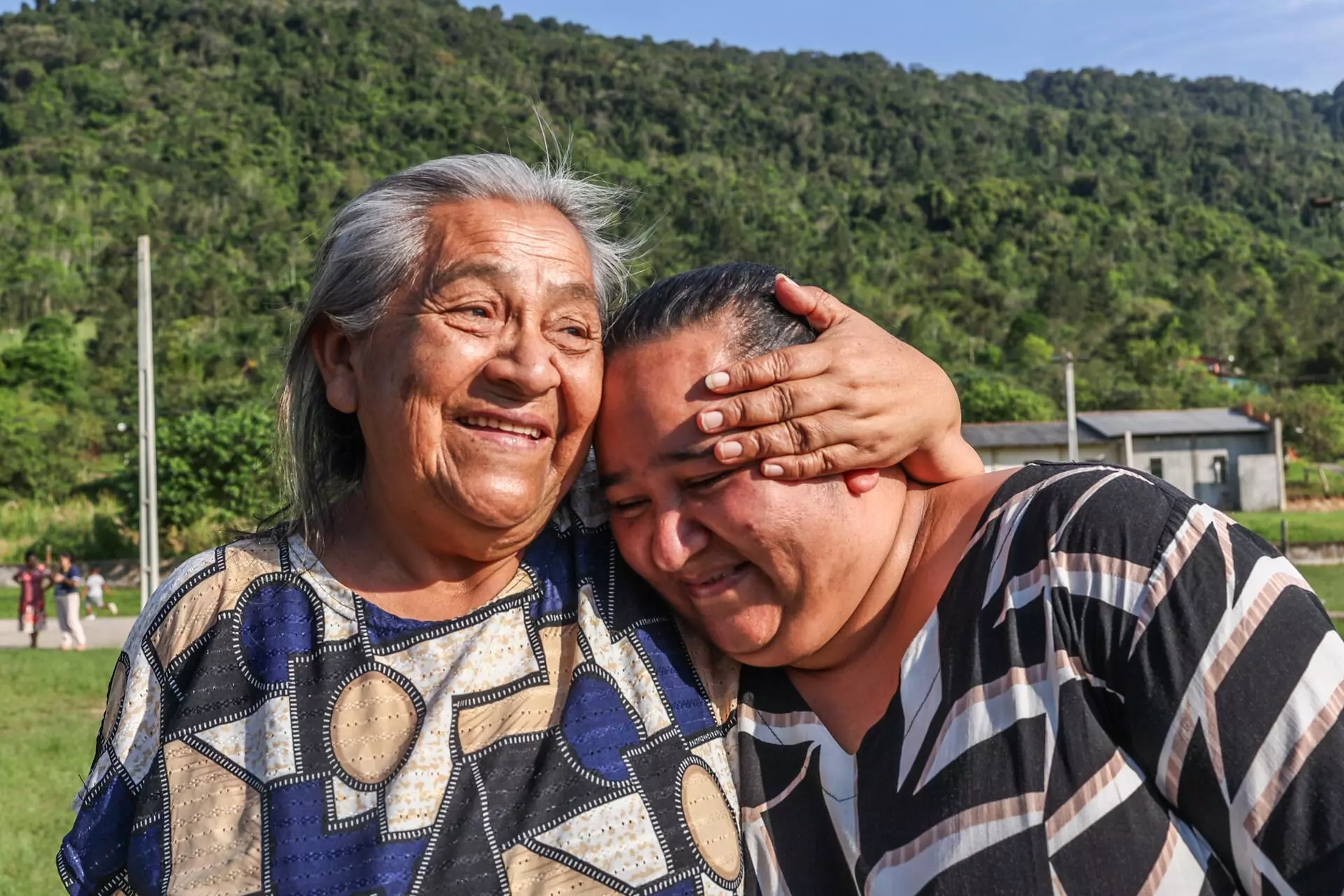
Diná Patté hugs her daughter Fabina Patté dos Santos, the vice cacica or second in command of the Ibirama-Laklãnõ Indigenous Territory. They are both celebrating the defeat of the historic cut-off point at the Supreme Court. Photo: Anderson Coelho/SUMAÚMA
Native rights to territories
Hearings on the historic cut-off point began when a motion was filed by the Environment Institute of Santa Catarina to recover possession of a nearly 200-hectare area partly located in the Sassafrás Biological Reserve. The Indigenous affairs agency, Funai, declared the area as traditionally occupied by Indigenous peoples. In the appeal, Funai contested a decision by the Regional Appellate Court of the 4th Region, in Porto Alegre, Rio Grande do Sul, which had ruled that the state government could recover possession of the land. The ambitions of Santa Catarina’s state government have now been struck down, due to a failure to consider native rights to the territory.
The case was first brought to Brazil’s courts in 2009 and it was only in late 2016 that it reached the Supreme Court, Brazil’s court of last resort. It was regarded by the Indigenous movement as the “trial of the century” because of its general repercussions; in other words, the high court’s interpretation extends and applies to all on-going and future processes for demarcating Indigenous territories.
The Xokleng were neither occupying nor disputing the territory in October 1988, but they were entering it to fish and hunt, according to the Indigenous people’s representatives in the case. As the lawyers understand it, there was never a good-faith occupation of this territory, since the Indigenous people were the target of constant persecution and extermination. Nevertheless, in the Supreme Court’s new interpretation, the case of the Xokleng would theoretically be one example where payment of indemnification for open land needs to be made before the demarcation process starts. “However, Justice Alexandre de Moraes, who first posed the idea of indemnification, argues that there is no good faith for the settlers and farmers who were occupying Xokleng territory, because of the violent usurpation. Yet we are still not sure [of the Supreme Court’s interpretation]. Our argument is that there were violent expulsions, with murders and the hunting of humans. Indemnification is not appropriate in the Xokleng case, in our view,” explains Rafael Modesto.
The Laklãnõ-Xokleng resistance seems infinite, even in the face of so much uncertainty. In addition to the emphatic and blunt demands for institutional accountability, the families persevere, dignifying and honoring their sages and elders. Wearing a headdress and holding her granddaughter Hannan Neli Patte Voigt, just 20 days old, in her arms, Isa Celina Moncona, 53, defines the feeling and the symbology of the moment: “It seems as if we’ve come out of darkness into light.”
Reporting: Angela Bastos and Rafael Moro Martins
Fact-checker: Plínio Lopes
Proofreader (Portuguese): Valquíria Della Pozza
Spanish translation: Julieta Sueldo Boedo
English translation: Sarah J. Johnson
Photo Editor: Lela Beltrão
Layout and finishing: Érica Saboya
Editors: Malu Delgado (news and content), Viviane Zandonadi (editorial workflow and copy editing), and Talita Bedinelli (coordination)
Director: Eliane Brum
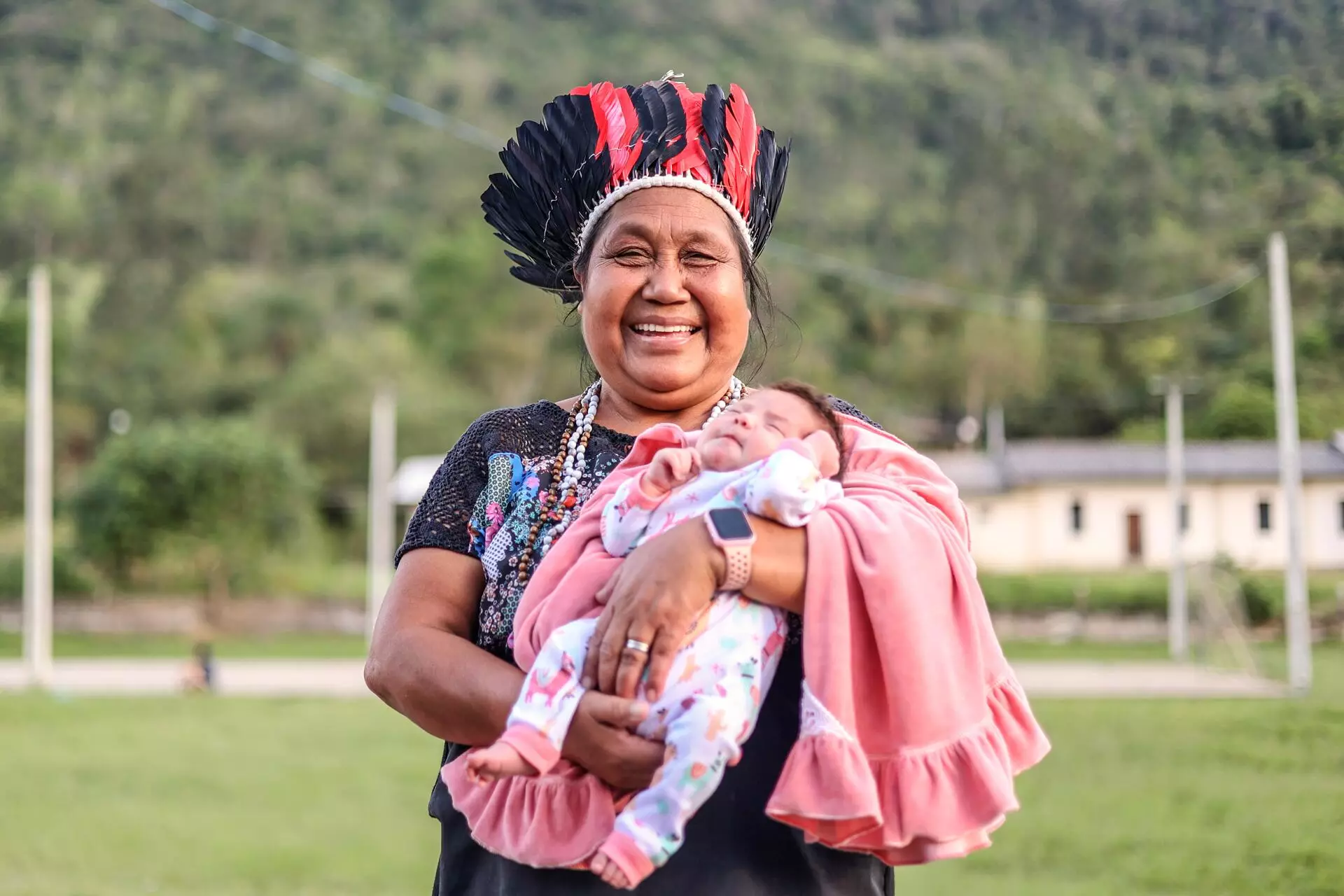
At the Laklãnõ school, Isa Celina Moncona holds her recently-born granddaughter. She put on her headdress in celebration of the final ruling by the Supreme Court. Photo: Anderson Coelho/SUMAÚMA





